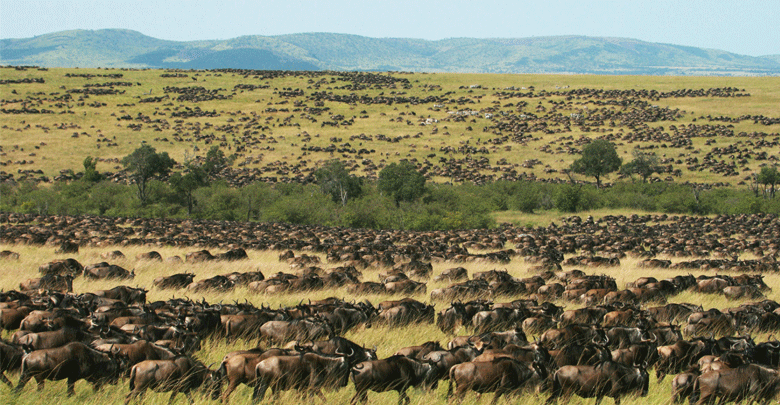Experts warn of Mara River’s pathway to ruin

The annual wildebeest migration spectacle from Tanzania’s Serengeti National Park to Masai Mara National Reserve in Narok is under threat.
Millions of gnus take a suicidal plunge across the Mara River.
Mara River is an important water body for biodiversity balance between Kenya and Tanzania, which are members of the Nile Basin Initiative (NBI) that comprises 10 nations. They are Burundi, DR Congo, Egypt, Ethiopia, Rwanda, South Sudan, Sudan and Uganda.
Nations share the riparian stretch that lines up West, East and North Africa.
However, recent increased human activities along the vast marshland has generated concern among member States and experts warn of dire consequences.
“Human activities are threatening most catchment areas that feed into lakes and rivers along the Nile Basin,” Gladys Wasike, Director, Transboundary Water at the Ministry of Water and Sanitation said at a workshop in Nairobi on Tuesday.
Issue of human activities is expected to be the main theme during the Nile Day marked annually on February 22 across Nile Basin countries.
It is marked to celebrate the establishment of NBI that was founded on February 22, 1999.
Economic potential
Nile and its tributaries is the lifeline for a population of 257 million people or more than 10 per cent of the population of Africa.
“However, the river Basin, despite its economic potential, is increasingly under pressure. Demands for water are on the spike due to population growth,” Wasike pointed out.
Proliferation of industrial agriculture, urbanisation and rising living standards, she said, are the cause of pollution of the estimated 6, 700-km stretch riparian land.
“Coupled with the climate change phenomena, the state of water catchments along the Nile Basin is increasingly threatened,” she noted, calling on governments to invest more in sustainable catchment conservation and management projects.
The value of this riparian land is estimated to be around Sh5 trillion to Sh6 trillion annually.
This is drawn from agriculture, hydropower generation, wetlands, water supply, navigation, fisheries and tourism such as the wildebeest migration among others.
Possible effort
In November last year, the Nile Council of Ministers meeting in Juba, South Sudan reached a consensus that governments must work towards every possible effort to restore one of Africa’s fresh water basins.
“Water is an irreplaceable, valuable, and shared resource hence its management deserves fair consideration on our journey to achieve sustainable development,” the Council’s outgoing chair, Jeanne d’Arc Mujawamariya, Rwanda’s Minister of Environment said.
Back to the Mara River, for three years consecutively since 2019, tourists landing there to watch the wildebeest migration have had to wait longer for the gnus to cross. The delay is attributed to the ecosystem interferences of the wildlife corridors.
“Demarcation of lands and change of land use that has led to rampant fencing in areas bordering wildlife conservancies, has affected grazing areas for the wildebeests, hence the crossing delays seen recently,” Wasike said.
At the workshop, the 10-member countries represented under the NBI, feel that it is high time to put together data on the potential of the river Basin. This involves analysing collected data in order to inform conservation efforts, and what each country needs to do.
Modathir Zaroug, NBI’s Regional Water Resource Modeller, said countries will be offered vast range of tools such as E-metres to help track how water users abstract the commodity, amount of water abstracted among other activities happening in the basin. “Under Goal 1 of the NBI 10-year strategy, the Nile-SEC intends to enhance the Nile Basin Data and Analytics Services,” he pointed out.
NBI, with support from the Nile Cooperation for Climate Resilience Project financed by the World Bank through the CIWA Trust Fund, seeks to expand its data and analytics services (NB-DAS) for climate-resilient water resources management in the Nile Basin through innovative information services for climate – resilient investment planning.
“This support seeks to strengthen the Basin Monitoring function of the Nile Basin Initiative,” he added revealing that over the years, NBI has been generating knowledge products from historical data that is freely accessible from the cloud to produce the basin monitoring bulletin and generation of actual evapotranspiration data sets.
These tools will help countries to share joint forecasting of flooding during the rainy season, which indirectly benefits 1.7 million people in urban and rural flood-prone communities.
In less than two decades, the Nile countries have transitioned from having little dialogue on water resources to an environment with active transboundary, regional norms and processes to share information, and joint prioritisation, planning, and implementation of investment projects.
NBI processes have led to a pipeline of nearly Sh600 billion of investment projects, for example, projects such as the Rusumo Falls Hydroelectric Project, which is financed by the World Bank and other partners. It is expected to generate power for Burundi, Rwanda and Tanzania.
Climate risks
As part of efforts to address climate risks, in October 2020, Kenya and Uganda endorsed the multi-billion-shilling Angololo Trans Boundary Water Resources Development Project that will be shared between the two countries.
The Angololo project, according to Wasike, will involve the damming of the Malaba River as a shared resource between the two countries along their common border.
“This is purely a trans-boundary project that is going on now. Once complete, it will address some of the economic challenges facing riparian communities who largely live below Sh100,” she said.
Project is at a feasibility study stage, and expected to end by June.
“Such a dam will enable a country to harness water for irrigation, hydropower and supply,” Wasike noted.
There are also various planned projects in other countries geared towards the same.
“Water quantity and quality is a major concern for the Nile Basin countries who think that the water levels must be maintained,” she added noting that some rivers go dry, such as the times when the Mara River’s water levels went down, the situation led to the delay in the seasonal wildebeest migration.















